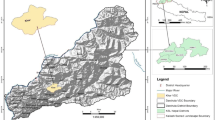Abstract
The use, processing, trading, cultivation and nurturing of wild edible herbs was recorded across a rainfall gradient in the Mpumalanga lowveld. Nine villages, in three transects across the prevailing west-east rainfall gradient, were sampled by means of 20 households per village. All households made use of wild edible herbs to some extent, with households in the wettest region using the greatest diversity. The duration of availability of selected species was increased through drying, storing and processing for later consumption. Such activities were more common in the drier regions relative to the wetter villages. Approximately 38% of the respondents cultivated or nurtured wild edible herbs within their homestead or arable fields, whereas more than 77% grew exotic commercial vegetables. One quarter of respondents traded in edible herbs, largely in the winter months. Very few obtained a significant income in this way, but even casual trading provided vital supplementary income for low-income households.
Similar content being viewed by others
Literature Cited
Acocks, J. P. H. 1988. Veld types of Southern Africa. 3rd ed. Memoirs of the Botanical Survey of South Africa 57. Botanical Research Institute, Pretoria.
Banks, D. I., N. Griffin, C. M. Shackleton, S. E. Shackleton, and J. Mavrandonis. 1996. Wood supply and demand around two rural settlements in a semi-arid savanna, South Africa. Biomass and Bioenergy 11: 319–331.
Brigham, T., A. Chihongo, and E. Chidumayo. 1996. Trade in woodland products from the miombo region.In B. Campbell, ed., The miombo in transition: woodlands and welfare in Africa. CIFOR. Bogor, p. 137–194.
Campbell, B. M. 1987. The use of wild fruits in Zimbabwe. Economic Botany 41:375–385.
Clarke, J., W. Cavendish, and C. Coote. 1996. Rural households and miombo woodlands: use, value and management.In B. Campbell, ed., The miombo in transition: woodlands and welfare in Africa. CIFOR. Bogor, p. 101–136.
Dolan, C., J. Twala,and R. Russo. 1992. Health situation analysis of the Bushbuckridgeregion of the eastern Transvaal. Unpubl. rep. Wits Rural Facility, Klaserie.
Dzerefos, C. M., C. M. Shackleton, and M. C. Scholes. 1995. Seed germination, nitrogen nutrition and water requirements of the edible herbCorchorus tridens L. Economic Botany 49:380–386.
Dzerefos, C. M., S. E. Shackleton, C. M. Shackleton,and F. R. Mathabela. 1995. Use of edible herbs and fruits from the Mhala-Mapulaneng region of the eastern Transvaal lowveld. Unpubl. report, Wits Rural Facility, Klaserie. 60 pp.
Fleuret, A. 1979. The role of wild foliage plants in the diet: A case study from Lushoto, Tanzania. Ecology of Food and Nutrition 8:87–93.
Food and Agriculture Organization of the United Nations. 1988. Traditional Food Plants. Macmillan Publ. Rome.
Gibbs-Russell, G. E.,and staff of the National Herbarium. 1985. List of species of southern African plants. Part 1. 2nd ed. Memoirs of the Botanical Survey of South Africa 51.
Gibbs-Russell, G. E.,and staff of the National Her- barium. 1987. List of species of southern African plants. Part 2. 2nd ed. Memoirs of the Botanical Survey of South Africa 51.
Griffin, N. J., D. Banks, J. Mavrandonis, C. M. Shackleton, and S. E. Shackleton. 1992. Household energy and wood use in a peripheral rural area of the eastern Transvaal lowveld. Dept of Mineral and Energy Affairs. Pretoria.
Guijt, I., F. Hinchcliffe, and M. Melnyk. 1995. The hidden harvest: the value of wild resources in agricultural systems. IIED, London.
Holden, P. L. 1991. Identifying constraints on smallscale agricultural production in the Mhala region of Gazankulu. B.Sc (Hons) dissertation, University of the Witwaersrand, Johannesburg.
Junod, H. A. 1927. The life of a South African tribe. Vol 2. 2nd ed. Macmillan, London.
Liengme, C. A. 1981. Plants used by the Tsonga people of Gazankulu. Bothalia 13:501–518.
Madovi, P. N. 1981. Food handling in Shona villages of Zimbabwe. Ecology of Food and Nutrition 11:133–144.
Malaisse, F., and G. Parent 1985. Edible wild vegetable products in the Zambezian woodland area: A nutritional and ecological approach. Ecology of Food and Nutrition 18:43–82.
McGregor, J. 1995. Gathered produce in Zimbabwe’s communal areas: changing resource availability and use. Ecology of Food and Nutrition 33:163–193.
Quin, P. J. 1959. Foods and feeding habits of the Pedi. Witwatersrand University Press. Johannesburg.
Rose, E. F., and A. J. Guillarmod. 1974. Plants gathered as foodstuffs by the Transkeian peoples. South African Medical Journal 86:1688–1690.
Sellick, E. C. H., and B. W. Bonthuys. 1990. Catchment study report. Water resources planning of the Sabie river catchment. Study of development potential and management of the water resources. DWA Report No. PX300/00/0590. CFP Project No: 131. RSA Department of Water Affairs. Volume 3.
Shackleton, C. M.,C. M. Dzerefos, S. E. Shackleton, and F. R. Mathabela. n.d. The use of and trade in indigenous edible fruits in the Bushbuckridge savanna region, South Africa. Ecology of Food and Nutrition.
Wehmeyer, A. S., R. B. Lee, and M. Whiting. 1969. The nutrient composition and dietary importance of some vegetable foods eaten by the !Kung Bushmen. South African Medical Journal 43:1529–1532.
Wehmeyer, A. S., and E. F. Rose. 1983. Importance indigenous plants used in the Transkei as food supplements. Bothalia 14:613–615.
Wilson, K. B. 1989. Trees in fields in southern Zimbabwe. Journal of Southern African Studies 15:369–385.
Zinyama, L. M., T. Matiza, and D. J. Campbell. 1990. The use of wild foods during periods of food shortage in rural Zimbabwe. Ecology of Food and Nutrition 24:251–265.
Author information
Authors and Affiliations
Rights and permissions
About this article
Cite this article
Shackleton, S.E., Dzerefos, C.M., Shackleton, C.M. et al. Use and trading of wild edible herbs in the central lowveld savanna region, South Africa. Econ Bot 52, 251–259 (1998). https://doi.org/10.1007/BF02862142
Received:
Accepted:
Issue Date:
DOI: https://doi.org/10.1007/BF02862142




